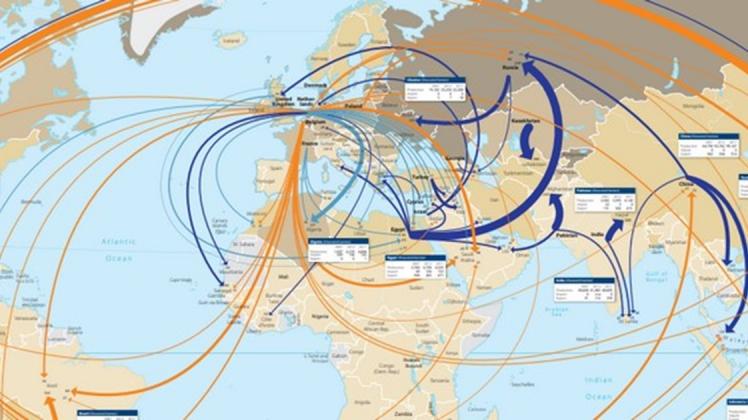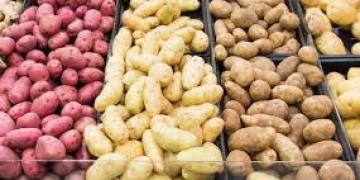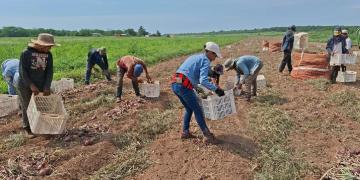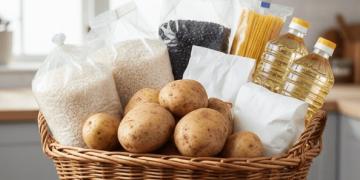Europa: World Potato Map 2019
Rabobank’s World Potato Map 2019 shows that the North-western European potato sector benefited most from the growth in global trade during the last decade.

During the last decade, developments in the global potato sector were dominated by the consumption growth of frozen processed potatoes. This benefited frozen processed potato producers in the Netherlands and Belgium, who doubled exports between 2007 and 2017. Potato growers in both countries also reaped the fruit of this development through a higher demand for fresh and seed potatoes.
Click here for a larger image.
Whether the next decade will be as successful as the last depends on how the potato sector in North-western Europe overcomes challenges regarding soil quality, tightening environmental standards, volatile price formation, and increasing global trade tensions hampering the flow of potatoes around the world.
Frozen processed potato trade - Four main countries
The market for frozen processed potatoes has seen tremendous growth over the last ten years. Since 2007, global trade increased by 3m metric tons, to more than 7m metric tons in 2017. Most of this growth took place outside of Europe and North America, with countries in Asia, the Middle East, and Latin America leading consumption growth. This increase in consumption is the result of higher disposable incomes, a growing middle class, urbanization, and the expansion of fast-food outlets in these countries.
Figure 1: GDP per capita vs. frozen processed potato consumption, 2017 Click here for a larger image.
Whereas potatoes grow in almost every country around the world, there are only four countries that have a significant frozen processed potato sector: the Netherlands, Belgium, Canada, and the US. Combined, these countries export more than 80% of all frozen processed potatoes. Although all four countries increased exports, frozen processed potato processors in Belgium were most successful. Belgium expanded its share in global exports from 18% in 2007 to 29% in 2017.
Cost-effective production of frozen processed potato products requires a year-round supply of high-quality potatoes. To achieve the yield necessary for processing, potato growers in North America and Northwestern Europe invested in knowledge, mechanization, storage, and irrigation. As a result, the yield per hectare is more than 40 metric tons in both regions (see Figure 2).
The prerequisite of yield, quality, and year-round supply means that the barriers to entry for frozen processed potatoes are high. This gives processors in the four exporting countries a favorable export position. On the other hand, this position makes the sector vulnerable to trade tensions, as recent import tariffs on the export of European fries to Latin America have shown. A way to overcome the risk of such rising trade tensions is to diversify production geographically.
Figure 2: Average potato yield, 2013-2017
Click here for a larger image.
Dutch seed potatoes are planted around the world
Over the last ten years, the Dutch seed potato sector increased exports by 300,000 metric tons, to almost 1m metric tonnes in 2017. Other European countries such as France and Germany also saw their exports increase. With an export share of over 50%, Dutch seed potato growers are a very important source of high-quality seed potatoes.
Dutch seed potatoes are mainly exported to countries in North Africa, the Middle East, and Europe. Destination countries in North Africa and the Middle East often lack the infrastructure to produce and store high-quality seed potatoes, making these countries dependent on imports. Within Europe, Dutch seed potato exports have benefited from growth in the frozen processed potato industry, which requires specialized potato varieties.
A growing global population and increasing demand for frozen processed potatoes will drive the demand for high-quality seed potatoes in the near future. This supports the demand for Dutch seed potatoes. However, opportunities to expand seed potato acreage in the Netherlands are limited. This means that the sector could see a shift to new seed potato-growing regions in France and Germany, as well as setting up shop in important destination countries in North Africa and Asia.
North Africa and Asia expanding market share fresh potatoes
Between 2007 and 2017, the export volume of fresh potatoes grew by around 2.5% annually. Most of the trade in fresh potatoes takes place in Europe. A large part of European trade flows consists of fresh potatoes imported by the Netherlands and Belgium to feed a growing processing industry.
China, Pakistan, India, and Egypt are gaining prominence as fresh potato exporters outside of Europe. Egypt is a good example of a country developing its domestic potato sector. From 2007 to 2017, the country almost doubled fresh potato exports to 652,000 metric tons, quadrupled frozen processed potato exports – from a low base – and is an important importer of seed potatoes from Europe. <>As the example of Egypt shows, the development of regional potato hubs in North Africa and Asia opens new markets for manufacturers of potato harvesting, sorting and seeding equipment, seed potato suppliers, and frozen processed potato producers.
Source: research.rabobank.com
Fuente: https://www.freshplaza.com/article/9159609/world-potato-map-2019/




